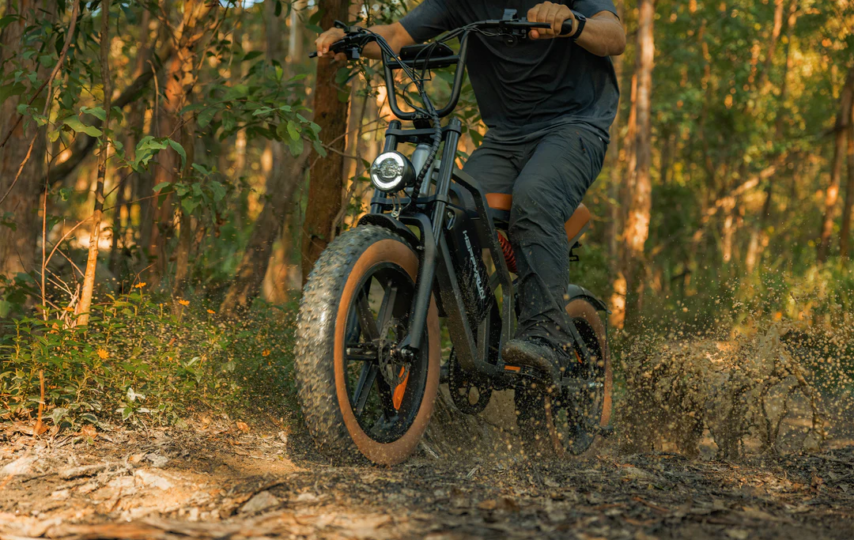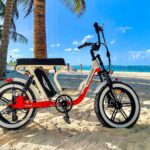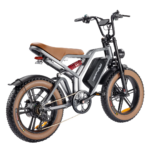Electric mountain bikes provide battery power assistance that opens up new possibilities for hitting trails and climbing hills. electric road bike offer electrified speed and performance on pavement. This comprehensive guide will explore the benefits of electric mountain and road bikes, key buying considerations, and recommended models to enhance your cycling adventures.
Let’s hit the trails and roads to experience these exciting electric bike technologies!
Benefits of E-Mountain Bikes
Also known as e-MTBs, electric mountain bike provide important advantages:
- Requires less physical exertion climbing and on hills
- Tackle more challenging off-road trails and steep grades
- Experience more downhill runs per ride
- Expand your overall off-road range
- Smooth and stabilize rough terrain
- Adds thrill and speed to trail riding
- Appeals to wider range of trail riding enthusiasts
Key Components of E-Mountain Bikes
E-MTBs differ from standard mountain bikes by integrating:
- Mid-drive electric motor – Located centrally at pedal cranks to optimize power transfer and weight distribution on climbs. Allows precise application of power.
- Rechargeable lithium-ion battery – Typically 36V or 48V batteries ranging from 500Wh to over 1kWh for adequate capacity. Allows 30-80 mile ranges.
- Powerful disc brakes – Necessary for speed control and modulation. Hydraulic discs offer strong braking in all conditions.
- Suspension fork – Front suspension provides 80-150mm of travel to absorb bumps and add control descending. Some models add rear suspension.
- Wide tires – Knobby 27.5” or 29” tires 2.6-3.0” wide aid traction and absorb smaller bumps. Tubeless designs avoid pinch flats.
- Integrated display/controls – Displays like speed, distance, battery level, and power mode. Allow easy power adjustments.
Specialized e-MTB components take trail riding to a new level!
Buying Considerations for E-Mountain Bikes
Key factors to evaluate when selecting an e-MTB:
- Powerful motor – A mid-drive unit that provides ample torque for climbing steep grades without overheating. Look for at least 250W, optimally 250-750W.
- Battery capacity – Larger batteries provide more range. 500Wh is a good minimum. Some models offer 700Wh or more.
- Suspension – Front suspension is a must. 100-150mm travel optimizes bump absorption and handling. Rear suspension further improves traction and control.
- Strong brakes – Hydraulic disc brakes with large rotors provide the best speed modulation and stopping power on steep descents.
- Wide tires – Seek 27.5” or 29” tires at least 2.5” wide to grip loose terrain. Tubeless ready.
- Gearing range – A wide cassette gearing range allows maintaining cadences while climbing. Some have a 10-50 or greater spread.
- Wheel size – 29” wheels help rolls over obstacles better while 27.5” wheels offer a bit more agility.
- Frame materials – Aluminum alloy and carbon fiber constructions save weight. Steel is tougher.
- Riding terrain – Assess if an e-MTB matches the singletrack, gravel, hills and conditions you want to ride.
Prioritize power, comfort, control and quality components to find the right e-MTB for your trails.
Introducing Electric road bikes
Electric road bikes add battery-powered electric assist in a lightweight package for speeding across pavement:
- Streamlined for aerodynamics and speed
- Motors boost acceleration and climbing ability
- Maintain higher sustained speeds with less fatigue
- Recharge and resume riding over longer distances
- Explore roads beyond your normal range
- Reduce physical strain while still exercising
- Integrated displays and controls keep riding data handy
Electric road bike Components and Features
Key component differences from standard road bikes:
- Integrated batteries – Lithium-ion batteries ranging from 250W up to 500W integrated into the downtube or other frame areas. Lower center of gravity placement.
- Electronic shifting – Shift electronic derailleurs via buttons. Auto shift modes adjust based on terrain. Creates seamless gear changes.
- Geometry – Frame sizing and handlebar positioning strike a balance between aerodynamics and control. Allow both relaxed and aggressive positions.
- Disc brakes – Hydraulic disc brakes allow precise speed modulation. Larger rotors provide ample stopping power.
- Larger tires – Wider road tires from 28-40mm aid comfort and handling compliance over rough pavement sections.
How to Choose an Electric road bike
Considerations when selecting an electric road bike:
- Intended usage – Commuting, fitness training, adventure? Match the frame design and wheel size accordingly.
- Range needs – Estimate typical ride distances. Larger batteries over 400Wh provide 50-100 mile capacity.
- Terrain – Are long climbs or rough pavement involved? Seek ample torque and tire size for the conditions.
- Motor power – Look for smooth, quiet 250-350W mid-drive motors with decent peak wattage output for accelerations.
- Frame material – Carbon fiber is light but expensive. Aluminum alloy or steel adds affordability.
- Gearing – Wider gearing ranges suit hills. Are disc brakes included? Electronic shifting?
- Extras – Do you want fenders, racks, integrated lights or onboard tech integrations?
- Test ride – Evaluate motor assist smoothness, gear changes, seating position and handling firsthand.
Riding and Maintenance Tips
To safely enjoy your e-bike:
- Obey all road laws and wear a helmet when riding
- Recharge batteries after each ride and avoid complete depletion
- Check tire pressures frequently and lube the drivetrain
- Shift gears smoothly and don’t pedal excessively with motor off
- Limit off-road use for road bikes and vice versa
- Clean bikes after wet/muddy rides to prevent component wear
- Inspect brakes, shifters and suspension for function and wear
- Schedule yearly tune-ups with certified bike mechanics
Proper care extends component life so you get years of use from your e-bike!
Key Takeaways on Electric Mountain and Road Bikes
- E-MTBs amplify off-road trail riding capabilities with electric power assistance.
- Robust mid-drive motors, large batteries, quality suspension and disc brakes define e-MTBs.
- Electric road bikes blend electrification with aerodynamic performance for speed across pavement.
- Sleek motors, integrated batteries and electronic shifting optimize the electric road bike experience.
- Suspension, strong brakes, wide gearing ranges and wheel size affect e-bike capabilities.
- Test ride e-bikes to evaluate motor delivery, handling, comfort and key features.
- Proper maintenance and charging extends e-bike lifespan and performance.
- Ongoing innovation points to an exciting future for ebikes with smarter integration and riding aids.
Electrify your rides with the performance benefits of modern electric mountain and road bikes!







